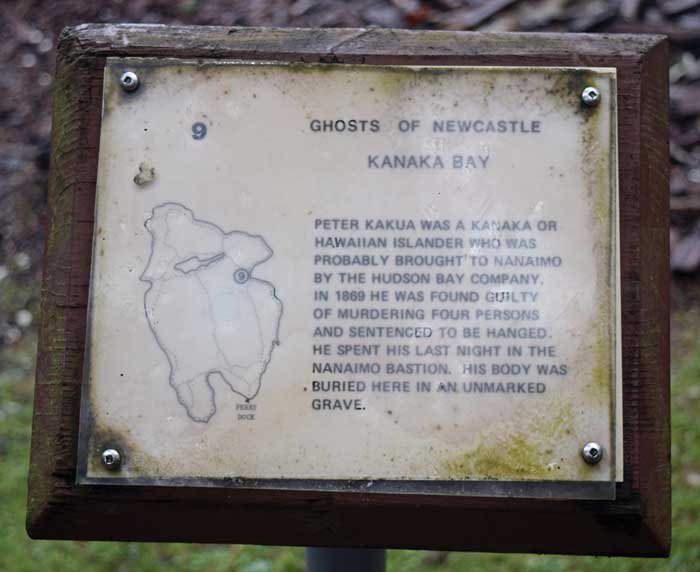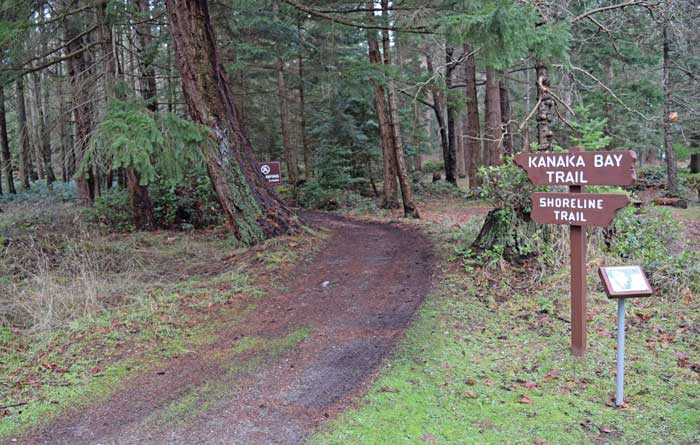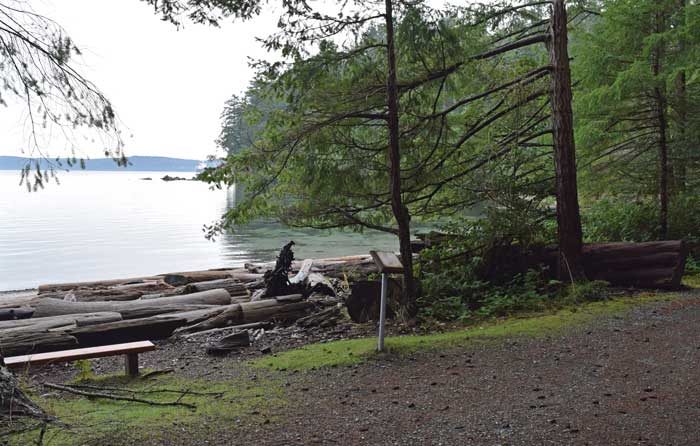Haunted on Saysutshun
Noelani Goodyear-Kaʻōpua is a Kanaka Maoli (Native Hawaiian) writer and educator. During a trip to Snuneymuxw territory, she was unsettled to find an apparently violent connection to her people on Saysutshun (Newcastle Island) when she came across Kanaka Bay and the story of so-called “Kanaka Pete.”
Celestine Aleck, a Snuneymuxw author and cultural support worker, said she has never come across any information in Snuneymuxw archives about the story, but that she has heard versions of the story from elders while she was doing research about Saysutshun.
“I know that when the coal-mining era began Saysutshun was purchased for $1.00, so Snuneymuxw never had a say as to Kanaka being buried on their land that has always been used as a place of healing,” Aleck said. “Since he was not from Nanaimo, he could not be buried there, so he was buried in the last place he was alive, which is now known as Kanaka Bay.”
By Noelani Goodyear-Kaʻōpua
As Canadians celebrated the150th birthday of their confederation and tell stories about the founding of their settler state, many Indigenous people celebrated 150 years of resistance. I am thinking about the thousands of First Nations women that have been murdered or gone missing in the past century and a half. I am thinking about the Canadian government’s insufficient inquiry into this issue.
I am also thinking about a story that has possessed me since my recent visit to Nanaimo. It is a story about a Hawaiian man who settlers have come to call, “Kanaka Pete,” and who slayed his “Indian wife,” Que-en; their infant daughter; and Que-en’s parents, Squash-e-lik and Shil-at-ti-Nord. Retellings of this ghost story speak of an axe murderer whose spirit still haunts the uninhabited island where he was buried. But so many of the other horrors that provided the backdrop to this violent act are hidden in these narratives. I felt compelled to retell this story in solidarity with #Resistance150.
Looking for things to do in Nanaimo, my kāne (man/husband) and I came upon a map of a small island off the coast. The name “Kanaka Bay” caught our attention, and we knew immediately that we had to go check it out. So, the next morning we caught a 10-minute boat ride over to Newcastle Island. Upon arrival, we found a sign maintained by the Snuneymuxw First Nation indicating that the island is part of their territory and its real name is Saysutshun. Intrigued, ʻĪmai and I pressed on, eager to find out how Kānaka had left their mark on this place. We figured it had something to do with the hundreds of Kānaka who had come to the Pacific Northwest on whaling and fur trading ships.
 My excitement turned to horror when we reached the bay and found a small sign that made brief mention of how the bay was named for a Hawaiian man who slaughtered his family in Nanaimo, then fled to, and was apprehended at, Newcastle. After being hung for his crimes, his body was buried in an unmarked grave at this site, and it became known as “Kanaka Bay.”
My excitement turned to horror when we reached the bay and found a small sign that made brief mention of how the bay was named for a Hawaiian man who slaughtered his family in Nanaimo, then fled to, and was apprehended at, Newcastle. After being hung for his crimes, his body was buried in an unmarked grave at this site, and it became known as “Kanaka Bay.”
Knowing the bones of a Kanaka might be somewhere under our feet, I wanted to give him proper respect. But I also wanted to learn more about this crime for which he was killed and to honor the people on whose territory he is buried. I couldn’t stop thinking about him and about his wife and her people. The swirl of emotions that standing at the edge of this bay stirred in me stayed with me for days, actually for weeks.
The gruesome story of Peter Kakua and Que-en, and the conflicting feelings that churned in my na’au, focused my attention on questions that have been posed by Indigenous feminists for many, many years now: How do we fortify our nations by reclaiming our own notions of family, gender and sexuality? How do we confront the violences of patriarchy while loving and honoring our men, as vital parts of our nations? How do we raise up our women? How do we hold people in our communities accountable for individual acts of violence while not losing sight of the larger systems of violence and exploitation in which they are situated? How do we mourn Native women and men who have been murdered, gone missing, or taken their own lives, remembering them and retelling their stories, without replicating the traumas they suffered? How do we rematriate?
I chanted softly at the mouth of the bay, not knowing the protocols of the Snuneymuxw people. We stood in silence before we left the shore and crossed over to other parts of the island that were quarried for sandstone and mined for coal. If emptiness and thick presence can coexist, I felt them here.
Settler retellings of the story of “Kanaka Pete” draw on the worst, dehumanizing stereotypes of Indigenous people—drunken, violent, incestuous, irrational, at times pitiful and at others straight up evil, and certainly barbaric slaves to their own impulses. In some versions, Peter is represented as so drunk that he had practically no control. In some versions, seeing his wife having sex with her father sends him over the edge. In no version do we learn much about Que-en herself. It took me digging up a 1972 article published in the Hawaiian Journal of History to learn that she and her parents were from the Penelakut tribe, not Snuneymuxw. But the horror stories tell us nothing of her, usually not even her name.
So many structural and material violences are left out of the sensational ghost stories. I recount a few of those violences here. In so doing, I do not mean to exonerate Peter Kakua. But how can I visit the sands of his grave on this island so far from the sands of his birth, without bringing him some aloha, some recognition, some attempt to understand the life he was living? Where would I go to pay homage to Que-en and her daughter? How can I visit the territories of the Snuneymuxw and Penelakut peoples without offering some mihi (repentance, remorse) for the part that one of my people played in violences against their people and lands?
 The Snuneymuxw nation’s signage tells us this is a sacred place: “Those who carried the gift of spirituality and healing came to the island for spiritual training.” The tiny island was also part of the Snuneymuxw people’s migratory patterns; they moved with fishing cycles.
The Snuneymuxw nation’s signage tells us this is a sacred place: “Those who carried the gift of spirituality and healing came to the island for spiritual training.” The tiny island was also part of the Snuneymuxw people’s migratory patterns; they moved with fishing cycles.
In the late 1840s, white settlers heard there was coal on this island. Once they confirmed the presence of coal on Saysutshun, settler companies began digging mine shafts, and a short but intense period of extraction ran from 1853-1856. The Hudson’s Bay Company owned the fields for some time but sold them by 1862. Colonial miners dubbed the island “Newcastle,” after the port city in the UK that was part of the oldest and most intensive coal mining industry in England. By 1854—in the midst of the coal rush—colonists in Nanaimo pushed for a treaty between the British Crown and the Snuneymuxw, alienating the first people and fixing them in place.
It was in 1853 that Peter Kakua left Hawai‘i and began working for Hudson’s Bay Company (HBC). It was a time of population collapse and rapid change in Hawai‘i. We don’t know why Kakua left—for adventure, opportunity, tragedy, necessity? But we know that he was one of hundreds who were recruited by HBC. In any case, he worked for the company on contract, as did many Kanaka, and then he went on to work for James Douglas, the Governor of Vancouver Island (who was also the head of HBC in that region). Since the 17th century, the British crown had given HBC monopoly trading rights over about 15 per cent of all the lands in North America, and the corporation was de facto colonial government over much of that territory through the mid-19th century. By the mid-1860s, Kakua found himself working for the Vancouver Coal Company at Nanaimo. It was there that he and his common-law wife,
Que-en, set up a modest home and had their baby girl.
Many of the stories begin with a drunk Kanaka Pete running, returning home from a night of drinking just as his wife, assisted by her parents, was packing up to leave him. A “failed marriage,” they say.
Colonial legal records show that in December 1868, Peter Kakua admitted to having killed his wife, daughter and parents-in-law with an axe in their home. He was hunted, tried and executed by white authorities.
Mind you, this was not an established Canadian legal system that you might imagine. Corporate interests were deeply tied to what was becoming the settler government. In 1849, the British government leased Vancouver Island to the Hudson’s Bay Company including the right to govern it. So many Kānaka settled in the area around HBC’s headquarters in Victoria that the area was called “Kanaka Row.”
The judge, Joseph Needham, who sentenced Kakua was a British barrister who arrived to serve a five-year term as chief justice only three years before Kakua’s trial. He became known for doling out hangings in a few highly-controversial cases involving conflicts between Indians, Blacks and Kānaka. This fact and the ways that the stories of “Kanaka Pete” represent his relationship with Que-en as an unsuccessful marriage remind me of Dian Million’s insights about “the white patriarchal state, a state that first destroyed and then substituted itself for their family and that can then sit in paternal judgment of their ʻmorality.’”
I wonder what it would be like to live in such a cold place thousands of miles from home, with no way back, and to suddenly confront the reality that you could be without a family. What is it like to wake in pools of their blood and feel the weight of their deaths sitting on your back?
I wonder what was Que-en’s life was like. What knowledges did she hold in her hands? In her feet? In her gut? How long had she dealt with men who unleashed anger about the conditions of the lives onto her body? How did it feel to give birth in a time of land theft and rapid settlement? In one account, she and her parents were loading her things onto a canoe. What was their intended destination? If she had escaped, what stories would she whisper to her daughter? Whose names would she speak like medicines?
Settler stories say that the morning after the killings, Kanaka Pete tried to escape to the mainland, near Vancouver, but stopped off at Newcastle to drink some more and to drop off a companion. None of them mention that his friend, Adam Stepney, was Black, nor that there was a substantial population of free Black settlers that had been invited to the area by the Hudson’s Bay Company. In fact, the first large wave of Black settlers to British Columbia were Californians who had been invited by James Douglas. Douglas’s mother was an African Creole from the Caribbean.
Constables apprehended Peter Kakua and Adam Stepney, taking them back to Nanaimo where Peter was jailed. The Coroner’s Inquest, the first inquiry into the cause of the deaths happened so quickly thereafter that neither the Penelakut nor the Snuneymuxw had the opportunity to bring Kakua into their own sovereign processes of justice and restitution. What authority did settlers have to pass judgement for violence committed on Penelakut bodies, on Snuneymuxw territory? Were Penelakut relatives able to come and collect the remains of Que-en and her family? Did they conduct their own mourning ceremonies? The settler narratives don’t ask these questions.
Ghost stories do not mention that Kakua’s defense attorney requested several documents from the Attorney General, Henry Crease, but never received them. They don’t mention that the Hawaiian Consul—representing the independent Hawaiian Kingdom—requested on this Hawaiian subject’s behalf that Kakua’s counsel draw up a petition for commutation and mercy. The Hawaiian Consul offered evidence from a statement collected from Kakua in Hawaiian at a meeting two weeks after his trial. Peter admitted to killing his family, but he indicated there was self-defense involved because his father-in-law had come at him with an axe when Peter tried to pull him off of Que-en. The petition was ineffective.
There was never an opportunity to make such a petition for Que-en, her life cut short at the convergence of threatened Native masculinity, extractive corporate industries and a nascent settler state.
Peter Kakua was executed on the morning of March 10, 1869, making no public remarks. The year after Que-en, Squash-e-lik, Shil-at-ti-Nord, and the baby girl were killed, the Vancouver Coal Mining and Land Company began quarrying sandstone from Newcastle Island. The company had been contracted by Joseph Emery of the United States Mint in San Francisco. Much of the sandstone that was taken from Saysutshun went to the construction of monoliths to settler colonialism and settler capital, so deeply intertwined.
That same year, 1869, the Hudson’s Bay Company turned most of its lands—the ancestral and unceded territories of numerous First Nations—over to the newly-formed Canadian government.
Thirty years later, in 1899, workmen of the New Vancouver Coal Company unearthed Peter Kakua’s body accidentally. In just thirty years, his story had become so invisible that settler authorities undertook a physical autopsy just to figure out who they had disturbed. They eventually reburied him, but the story of “Kanaka Pete” was resurfaced and took on a new life.
While haunted by Peter and Que-en’s story, I learned that Saysutshun has traditionally been used by the Snuneymuxw as a place of healing. When someone passed away in the community, loved ones would go to the island to yu’thuy’thut, to fix up their heart, mind and body; to “let go of their tears.” Little did the colonists who buried Kakua know, Kānaka often buried our dead in unmarked graves at sandy shorelines.
And so, we sat between the resting place of this Kanaka, the earthy caverns emptied of coal, and the piles of discarded sandstone next to the old quarry. We walked about trying to find the best way to move amongst these skeletons, giving them due respect without stepping too boorishly or making too much noise, and yet remembering Dian Million’s insight: “colonialism’s strongest defense” is silence.
E Peter, e Que-en, e Squash-e-lik, e Shil-at-ti-Nord, e pē, e Stepney–
There may be no stories that can make up for the violences Kānaka inflicted or were complicit in on these lands, but our genealogies are woven together, for better and for worse. Let the protective curves of this bay hold the fullness of your stories, the complexities and colors of your emotions. Let the rotting seaweed become nourishment for new life. Let the abandoned mine shafts fill with potential energy. Let the logs cut by corporations, yet escaping capture, float into this bay and line the shore like an amphitheater for audiences of ancestors. Let us sit and tell stories that heal. Let us make spaces for the multi-generational legacies of sexual trauma that our peoples continue to carry be aired, so that no man or woman commits such harms again.
Noelani Goodyear-Kaʻōpua works as Associate Professor of Indigenous Politics at the University of Hawaiʻi. You can contact her and view more of her writings at noegoodyearkaopua.com.




